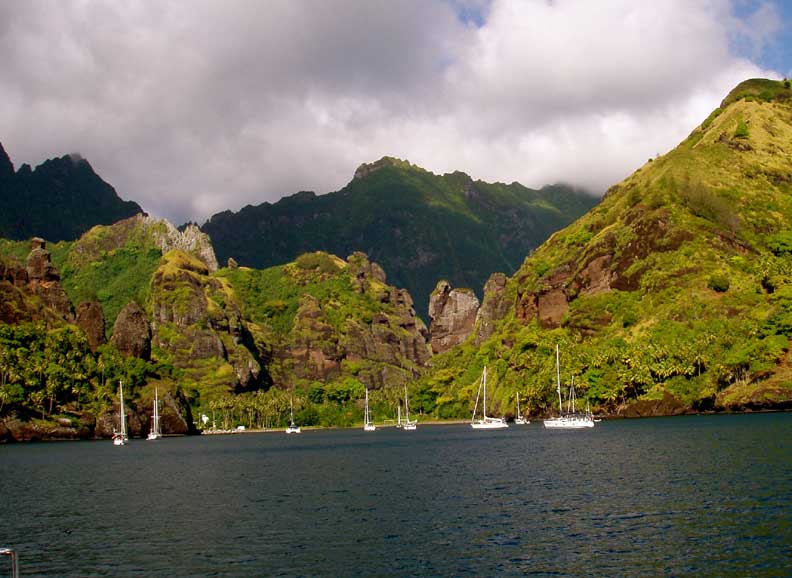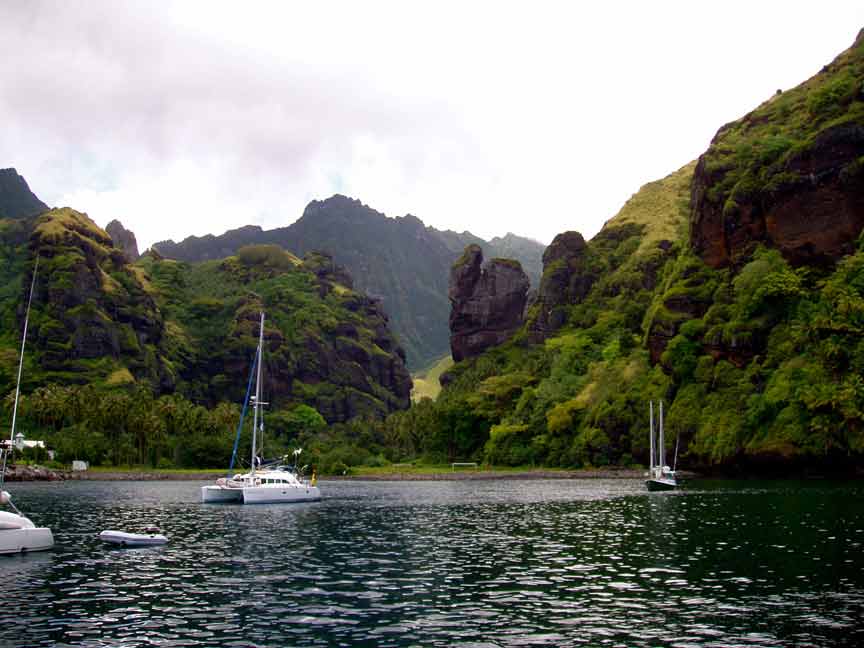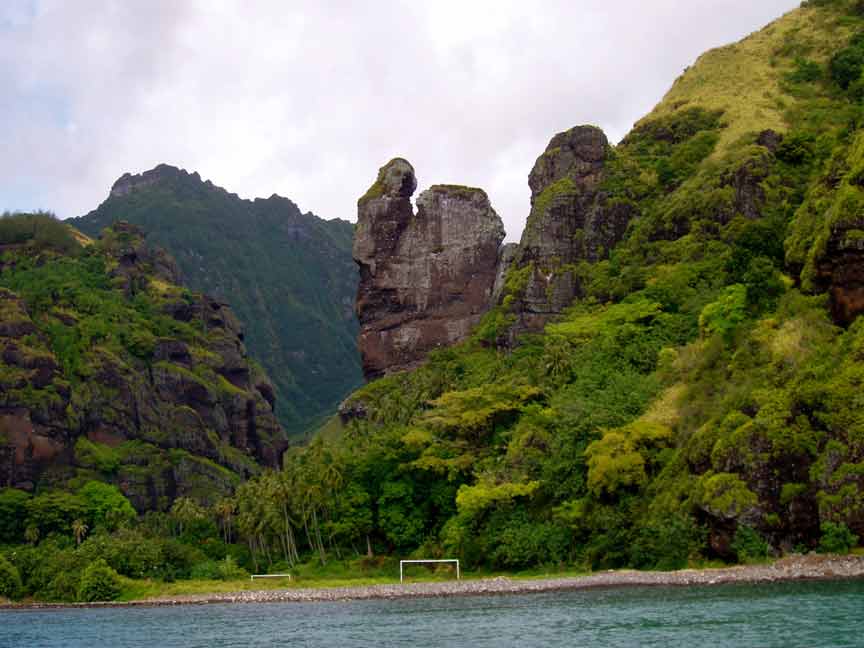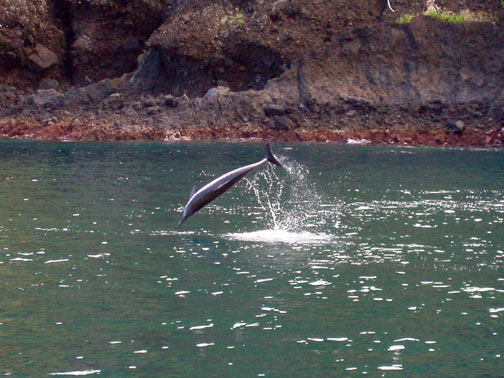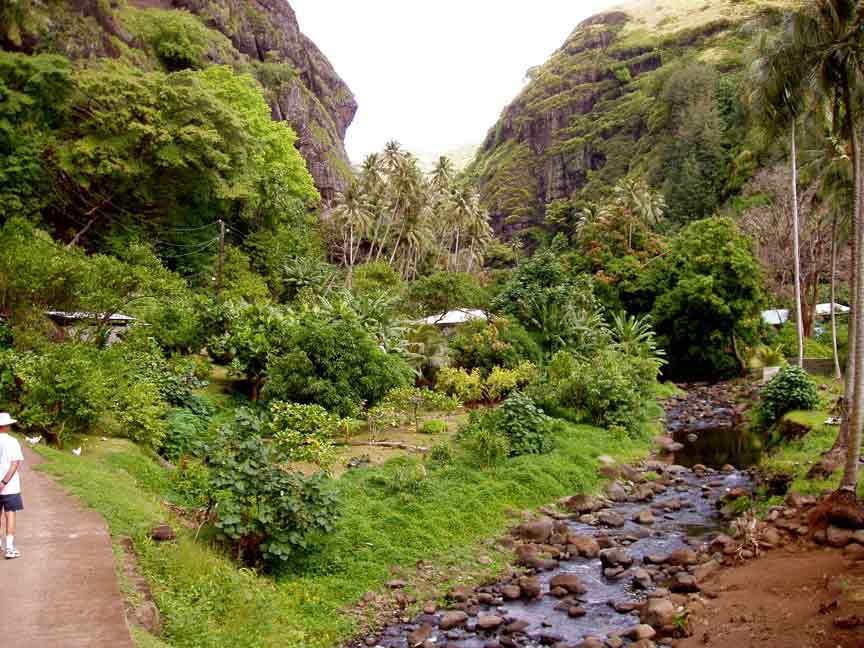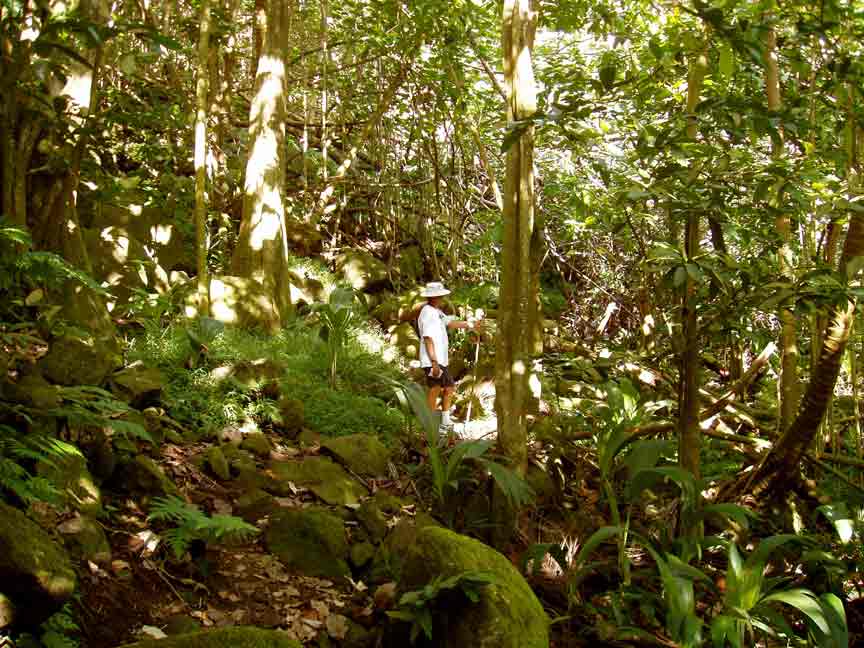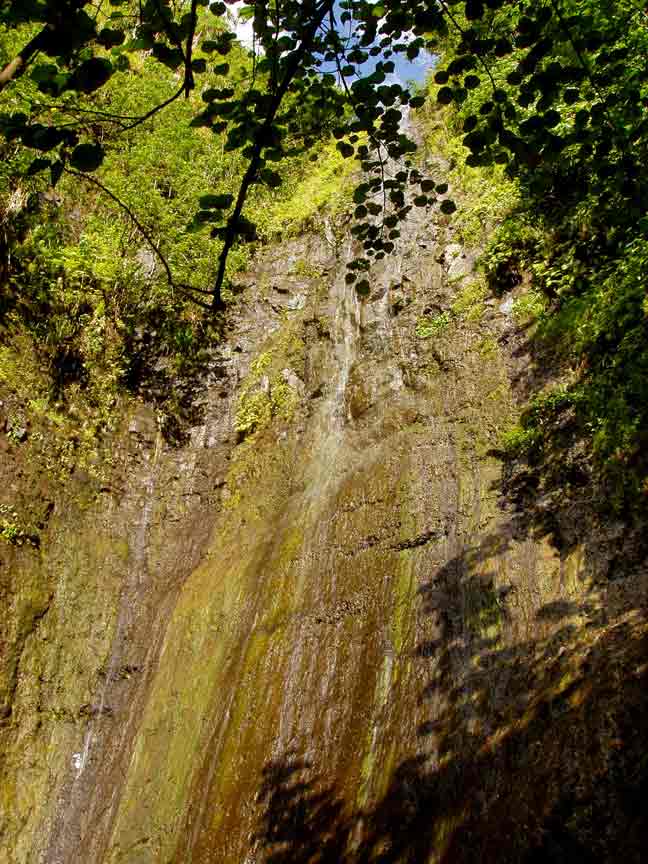Hanavave Bay, Fatu Hiva Island, Marquesas

Harmonie
Don and Anne Myers
Fri 11 Apr 2008 20:41
|
10:27.881S 138:40.697W
Last Friday (4/4) we sailed the thirty-five or so
miles southeast from Hanatefau Bay on Tahuata Island to Hanavave Bay on Fatu
Hiva Island. Normally, it would take us five hours or so to sail
thirty-five miles, but because we were sailing straight into the prevailing wind
doing the long-forgotten zig-zag sideways crawl, it took us close to nine
hours. We've been so spoiled with relatively smooth downwind sailing that
the upwind sail that day felt a bit uncomfortable and even the boat wasn't too
happy about continuously crashing into and through the waves splashing salt
water all over itself. We did survive the upwind sail though, and
were rewarded with the most fantastic scenery the Marquesas have to
offer.
Hanavave Bay or the 'Bay of Virgins' as it is
sometimes called, is billed as the most beautiful bay in the Marquesas, and
graces the cover of several of the guide books we have for the area. After
having visited eight bays in the Marquesas so far, we would say that the Bay of
Virgins beats them all hands down when it comes to pure majesty. Pictures
1, 2 and 3 below show the bay as we approached, anchored, and motored to shore
in the dinghy. Again, the pictures don't quite do the scenery justice
(especially after dumbing them down for the web), but hopefully they'll
give you the general idea of the place. To us, it felt like we
had dropped into the Lord of the Rings movie set, and several of the elves were
going to appear from behind the rock spires at any moment. None did, but
maybe we just weren't paying attention at the right time?
Upon arrival in the bay, we noticed three rally
boats were present along with seven other non-rally boats.
Taking advantage of a golden opportunity, we loaded twenty-five bananas and
fifteen limes into each of three bags, put the dinghy in the water and delivered
the fruit to Nutella (Spanish), Ideal and Lady Kay (both British). All
three thanked us and thought we were doing them a big favor when in
fact it was really them doing us the big favor by putting a dent
in the six hundred pounds of fruit ripening fast and attracting bees in our
cockpit.
We learned from Lady Kay that although there
were no restaurants in the small village, there was a woman who had offered
to cook dinner for them in her family's house that night for a fee.
The concept sounded good to us so we went to visit the woman at her house in the
village to make our 'reservation' for that night. When six o'clock
arrived, we joined up with the three crew from Lady Kay (and later three from
Nutella as well), parked the dinghy behind the small breakwall, crawled up onto
the concrete wharf (not easy at low tide) and walked up the main concrete
village road. Two women approached us and asked if we needed help finding
our way. Once it was determined that Kathie was the woman we were looking
for, one of the women quietly guided us through the dark village to
Kathie's house. Along the way she broke a few small branches off a
particularly lovely shrub and offered them to me. They are still
looking quite nice in a vase on the boat.
We arrived at our dining destination, which was
the open front porch of a small, tidy house - set up with two tables
pushed together, flowered plastic table cloths and a medium sized fluorescent
light (similar to one that might be hanging in your garage) for
ambiance. Everyone had a mismatched plate and a fork. We
asked for a knife, and did receive one. Just one. So we
snickered about it and proceeded to share the one knife as needed.
There were about nine different dishes. All of them local recipes
made from local ingredients, most of them excellent. There was grilled
fish (the whole fish, head and all), barbequed goat (no, it didn't taste like
chicken - tasted more like lamb and was quite excellent), raw fish marinated in
lime and soaked in coconut milk (Don and I were not brave enough to try it, but
the Brits said it was good), a kind of coleslaw made from papaya, grilled
breadfruit (not my favorite, but the breadfruit did taste strangely like bread),
some kind of spiced chicken, rice, bread, yams and chunks of sweet grapefruit
for dessert. We brought our own wine and compared boat stories with the
other boaters. Like, how best to try and sleep when underway and the boat
is rolling side-to-side a good forty-five degrees. Which, by the way, the
crew from Nutella suggests sleeping cross-wise in the bunk so the roll affects
you head to toe instead of side to side. An interesting
concept.
Towards the end of the meal, the man of the house
played guitar for us and also displayed his incredible rosewood and stone
carving work. Although tempted, we didn't buy anything this time. So
ended our first truly local meal.
The next morning all the anchored boaters were
greeted by a pod of spinner dolphins that came into the bay for a visit and a
show. These dolphins are smaller than those we've seen before, and black
in color. The acrobatics they performed for us were amazing and definitely
more complicated than the usual dolphin maneuvers. These guys propelled
themselves out of the water several feet, completing triple flips and
quadruple twists - all in a matter of seconds. Just incredible. Some
of the boaters closed in on the performers in their dinghies and others slipped
into the water and were able to get very close as the dolphins swam
and jumped and twisted right next to them. The show was so close to
our boat all we had to do was sit on the deck and
watch. The performance went on for a good half-hour, and in that
time I snapped about fifty pictures - only two of which actually caught
the dolphins in action (the remaining 48 show a nice view of the water splash
after the dolphin disappeared under the water). Picture 4 below is one of
those two.
Later that day, we put on our socks and sneakers
(first time for socks in months! it felt really strange) and headed to shore to
hike up to the 200 foot waterfall we had heard about. The supply ship had
arrived in the bay that afternoon and was unloading supplies onto a small barge
that ferried them to shore. This being a big event, the entire population
of the village had turned out and was down by the wharf watching the
supplies come in. We happened to arrive in our dinghy just as
all of this was going on and had to thread our way through the
watching villagers to get to the main road leading out of the village. As we
walked through the 'crowd' (not all that many people), we stuck out like the
tourists that we are with our socks and sneakers and big hats and cameras and
sunglasses, and many of the kids approached us asking for 'bo bo' (candy).
We didn't have any, but didn't feel too badly. Most of the kids that
approached us looked like they had gotten plenty of 'bo bo' from other
boater/tourists that had come before us.
We followed the narrow concrete road to the edge of
the village, and started to make our way up and out of the valley. Picture
5 is a view of the stream that runs through the village with a few houses
nearby. Everything was so green and lush that every step along the way
would have made a pretty picture. Up we went, beyond the end of the
concrete road, turning off the two-track dirt road onto a one-track path leading
through the forest. The path got narrower, steeper and more rocky as we
went along until it almost completely disappeared and we were left to
scramble up rocks, boulders, over tree stumps and through rainforest
foliage looking for signs that we were still on the right path.
Occasionally the path was marked by a few stones stacked on one another, and
after a while we could hear local kids yelling as they played in the pool at the
foot of the waterfall. Picture 6 shows Don trekking through the
forest. Just as we approached the waterfall, the local kids were packing
up and leaving. Some saw us coming through the trees and bellowed,
'Touristas!' to their friends. We weren't sure if this was a warning or
just a general proclamation to their friends, but we felt our arrival had
certainly been properly announced. We arrived at the base of the waterfall
after our one and a half hour, extremely sweaty trek, and were a bit
underwhelmed. The waterfall was as tall as we had read, but there was so
little water trickling down (it's dry season here in the Marquesas), it was
tough to tell that it was a waterfall. Also, the pool at the bottom wasn't
necessarily something we wanted to swim in. It certainly wasn't polluted,
but the water was murky and we had heard there were many crayfish, so we didn't
go for a dip. After swimming in clear turquoise water for five months, we
have a low tolerance for murk. Picture 7 is the upper half of the
waterfall (it was too tall to fit in one picture and the stream bed was too
treacherous to try and scramble down for a better picture). We sat for a
bit enjoying the solitude (like we don't already get enough of that on the boat)
and then made our way back down.
That about sums up our stay on Fatu Hiva. The
next day (Sunday, 4/6) we planned to sail the forty or so miles back to relative
civilization on Hiva Oa to take care of some internet stuff and buy more giant
bread. More on that later.
Anne
|
